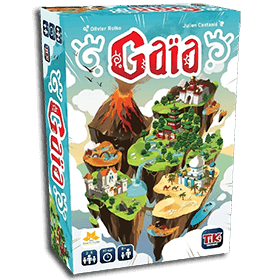Gaïa
 Gaïa é um jogo desenvolvido por Olivier Rolko e publicado por TIKI Editions.
Gaïa é um jogo desenvolvido por Olivier Rolko e publicado por TIKI Editions.
Número de jogadores: 2 - 5
Duração do jogo: 16 mn
Complexidade: 2 / 5
Jogue Gaïa e 1166 outros jogos online.
Sem downloads, direto no seu navegador.
Com seus amigos e milhares de jogadores do mundo inteiro.
Grátis.

Jogue Gaïa e 1166 outros jogos online.
Sem downloads, direto no seu navegador.
Com seus amigos e milhares de jogadores do mundo inteiro.
Grátis.

Sumário de Regras
GOAL:
Be the first player to finish placing all your meeples on cities or objectives.
Hand limit is 6 cards. (The advanced version limits you to no no more than 2 power cards per hand).
On each turn, a player can take two actions:
- Draw a card.
- Play a card.
You can perform the same action twice in one turn.
There are 6 different types of Nature cards (plains, forests, seas, deserts, mountains, and swamps). Playing a Nature card allows you to place a corresponding Land tile onto the board.
There are 2 types of Life cards (animals and cities). To place a city card, you must play it on a land tile that corresponds with the icon in the upper left corner AND meet at least 2 requirements indicated on the bottom of the city card. Animal tokens placed on the land tile do not inactivate the land tile.
In the basic version, you can satisfy an additional city's requirement and place your meeple on the city card, even if your opponent is on it. In the advanced rules, you would replace your opponent's meeple.
FULL RULES:
Game Turn
On their turn, each player must take 2 actions amongst the following options:
- Draw a card.
- Play a card from their hand.
The player takes their actions in the order of their choice. You are allowed to play the same action twice.
Draw a card
The player can draw:
- One of the face up Nature or Life cards. The player adds it to their hand and reveals a new card from the corresponding deck. Or...
- One of the face down Nature or Life cards (taken from the top of the deck). A player is never allowed to have more than 6 cards in their hand. If they draw a 7th card, they have to discard a card of their choice from their hand without p laying it.
Play a card from their hand
Play a Nature card. Once played, the Nature card is kept face up in front of the player who played it. That player then takes a corresponding Land tile and places it next to a tile already on the table. The first tile played is simply put in the center of the table. A player may never play a Nature card if there are no corresponding Land tiles left.
Fulfill an Objective: When a player has accumulated all the Nature cards shown on an available Objective, they immediately discard all the corresponding Nature cards, and place one of their meeples on top of the Objective to indicate it is no longer available for other players. Note that Objective cards are never replaced during the game.
Play a Life card
There are two types of Life cards: animals and cities.
- Animals: The player puts 4 animal tokens on a free corresponding land tile (with no city or animals) then they discard the card. A star on the card means you can put the animals on any kind of land. If there is more than one corresponding land tile in play, the player chooses one single land tile to place their 4 animals. A player may never play an animal card if there are not at least 4 animals tokens left in the bank.
- City: The player puts their city card on a free land tile(with no city or animal) already in play. The city must respect the 2 following rules:
Rule 1: City land tile
A city with a star in the top left corner can be placed on any land tile except sea tiles. A city with a specific land icon in the top left corner can only be placed on a corresponding land tile.
Rule 2: City's satisfaction (minimum 2 needs)
To put a city on a tile, a player must satisfy at least 2 needs at the bottom of the card. A need is satisfied when the element shown (land or animal) is found on a land tile directly next to the city. Land tiles in diagonal are not taken into account. They then place one of their pawns on the city to indicate they own it.
Note: A city covers the land tile it is placed on. The neighboring cities may not use this land tile anymore to satisfy their needs. As a consequence, a new city can lower the satisfaction of the neighboring cities (see below). Animal tokens don't cover land tiles.
Increase a city's satisfaction
When a player increases the number of needs satisfied in one or more cities (for example, if they put animals or a new land tile in play), they must place a new people pawn on each city where they increased the satisfaction. A player may only have one people pawn of their color per city in play. If a city has animals on an adjacent tile, adding new animals tokens will not increase its satisfaction.
Reduce a city's satisfaction
This situation arises if:
- A new city covers a tile. This tile can no longer be used to satisfy the needs of the neighboring cities.
- All animal tokens next to a city have been consumed (see "Hunting and feeding") and the "animal" requirement is no longer satisfied for this city.
When you use Powers (only in advanced rules)...
- If a city has only 1 need satisfied: All pawns on the city return to their owners (pawns may be reused afterwards), but the city stays, empty, on the tile.
- If a city is no longer satisfied (0 need satisfied): All pawns on the city return to their owners (pawns may be reused afterwards), and the city is removed from the tile and discarded.
End of turn
If no one has won after the player has completed their two actions, the next player begins their turn.
Start of a new turn
Hunting and feeding
Before taking their two actions, a player must (if they is able) feed all their cities which have an animals icon. One animal per city in need of being fed is removed from an adjacent land tile (diagonals are not taken into account) and returned to the bank. If there are animals on several tiles around a city, the player chooses any one tile to take the animal from. If there are no animals around the city, you don't remove any tokens (the animals need is not satisfied). Remember to adjust the people pawns if needed.
End of Game and Victory
The game ends when:
- A player has placed all of their people pawns. That player wins the game.
- A player wants to draw a Nature card, a Life card or a Power card (in advanced rules only), but there are none left (either face up or face down). In this case, the winner is the player with the most people pawns on cities as well as objectives. In the case of a tie, the winner is (amongst the tied players) the next player sitting closest clockwise to the player who just ended the game.
Illustrated Example: Basic Rules
It's the beginning of the yellow player's turn:
- They must start by feeding their city in the bottom left, because that city has the animals icon. They remove the last animal from the desert, reducing the satisfaction of this city. Since the city now only has 1 need satisfied (desert), they must remove their pawn from the city.
- 1st action: Yellow plays a plain card and places a plain tile to increase the number of needs satisfied for the city on the top right (3 needs satisfied). This move allows them to put one of their yellow pawns on the city, next to the blue pawn.
- Yellow then adds the card just played to the other Nature cards they already have in front of them. They now have accumulated all the Nature cards shown on an available Objective. They discard their 4 Nature cards and fulfill this Objective by placing one of their pawns on the card. From now on, this card is not available to the other players.
- 2nd action: Yellow plays an animal card and puts 4 animals tokens on the desert. They increase the number of needs satisfied for the bottom left city to 2, so they add one of their pawns on the city. During their turn, the yellow player has removed 1 people pawn then put 3 pawns (2 on cities, 1 on an Objective).
ADVANCED RULES
Basic Rule Modifications:
- Stealing a city
From now on, when a player increases the satisfaction of a rival city, they replace the opponent's pawn by their own! The opponent's pawn is returned to their owner (it may be reused afterwards).
- The 4 Needs of a City
When a player satisfies all 4 needs of a city, they now place 2 of their pawns on that city. If the satisfaction drops back to 2 or 3 needs, remove one of the two pawns. When 1 or 0 need is satisfied, follow the basic rules.
https://www.redmeeple.com/site/images/Rules/Gaia_Rules(EN).pdf

